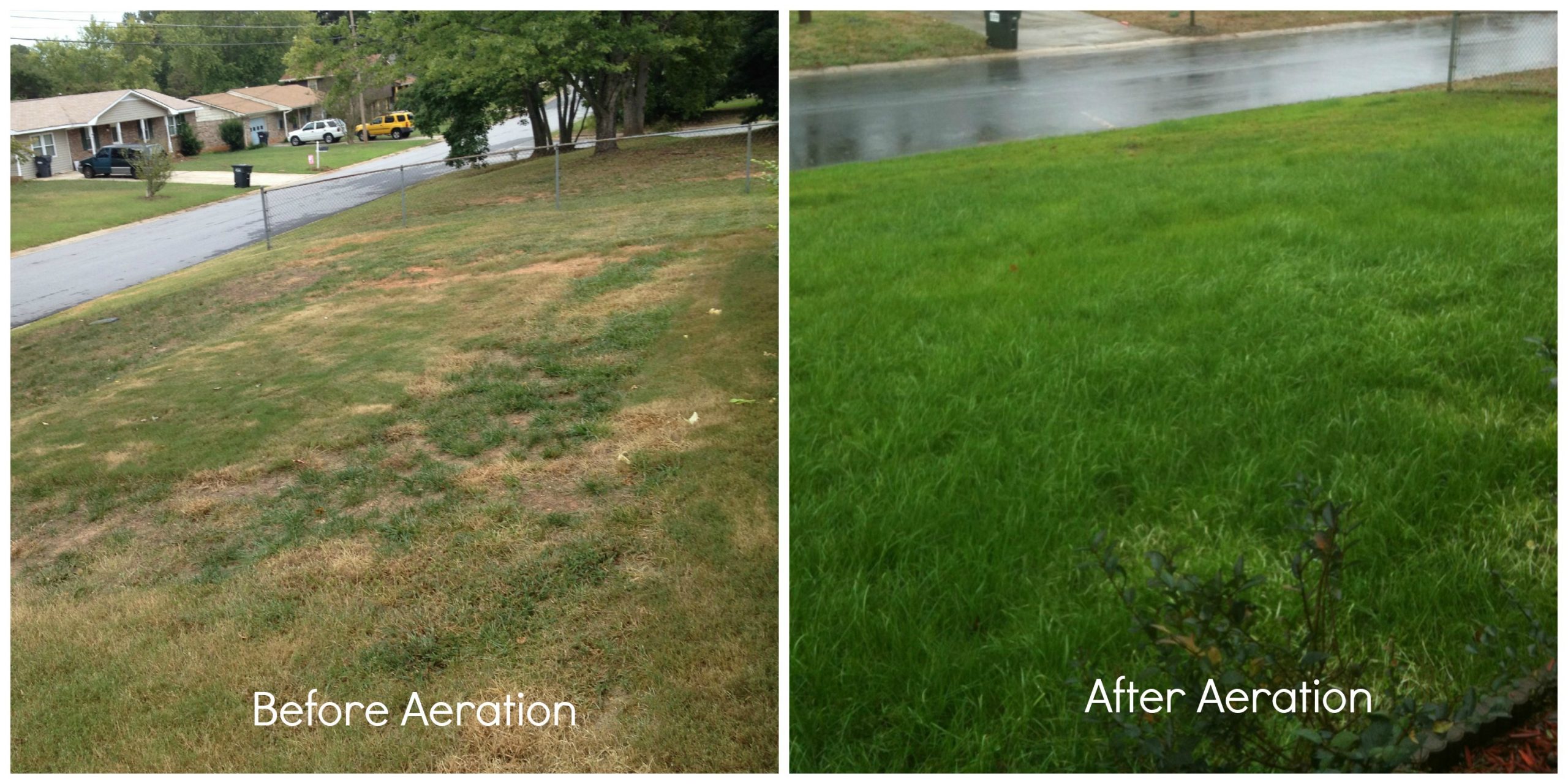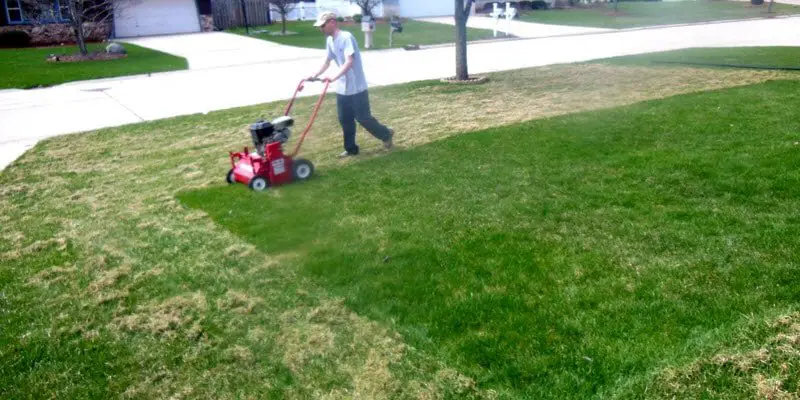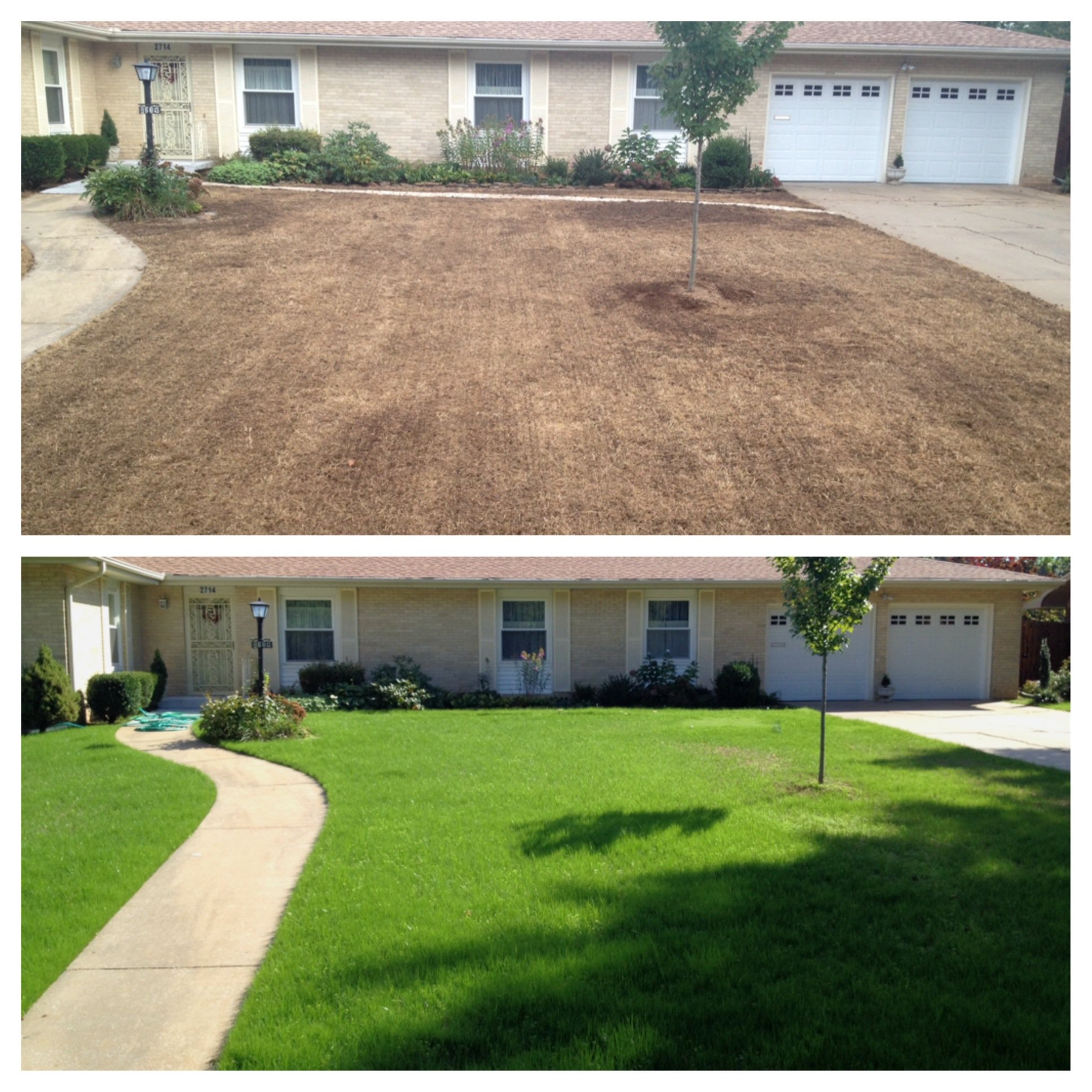Allow Soil Plugs To Break Down Naturally
After you use a core aerator, plugs of soil will be scattered across your yard. While it may be tempting to take some measures to clean up your yard, the best course of action is to allow soil plugs to dry and break down over time.
Mowing and regular lawn use, as well as precipitation, will gradually destroy soil plugs. This allows air and nutrients to mix with the soil, and allows water and fertilizer to easily enter the holes left by core aeration.
Best for: All lawns. Soil plugs left by an aeration machine should always be allowed to break down over time.
Pros Of Tilling Before Sod
The benefits of tilling before you lay a new sod lawn are enough to convince many to include this step when laying new sod in their lawn. The top reasons for tilling are:
- Loosens soil, allowing sod to take root quickly.
- Creates opportunity to mix grass-boosting soil amendments into topsoil.
- Tilled soil can be raked to change the slope of the yard.
- Especially beneficial for compacted or clay soils.
If you have a yard thats in need of fertilizer or the soil pH needs to be balanced with lime, tilling these amendments into the ground provides a big benefit. Additionally, loose soil encourages sod to develop deep roots that make for a healthy, drought-resistant yard.
Dont Fertilize Shady Areas More
People tend to over-apply fertilizer to shady areas because the grass is struggling. But that just kills it faster!
Many people really have two lawnsa lawn that gets full sun for most of the day, and a shaded lawn that may get only two to four hours of direct sunand their water and fertilizer needs are different. The grass in shady areas needs less water because less evaporates, and it needs less fertilizer because with less sun it doesnt grow as much. When you go into shade, shift the controls on the spreader so youre spreading about half the amount.
Recommended Reading: Scotts Summerguard Burned Lawn
How To Remove Grass After Tilling A Garden
Related Articles
Rototillers drastically decrease the time and effort it takes to turn a lawn into a garden. Cultivating the soil to get ready for planting is key to a successful garden. If you are planting a garden over grass, it is best to cut up and remove as much sod as possible before tilling. You can also consider applying an herbicide to kill the lawn.
After the tiller breaks through the remaining grass and loosens the soil, the grass remaining in the soil still can grow from its roots and/or seeds. Unless you want to fight weeds and grass throughout the gardening season, remove the remaining grass before you plant crops, advises the National Gardening Association. Do not till the soil or attempt to remove grass when the soil is wet because doing so can lead to hard soil clumps and soil compaction, advises Lowes.
Remove The Existing Lawn

Removing and killing your existing grass is the first step. One easy method is to apply an herbicide for grasses on your lawn. Multiple applications may be necessary, notes Fine Gardening. This method may damage or kill nearby plants, so to avoid this risk, consider using another method, such as smothering the grass.
Smother the existing lawn by covering it completely with plastic that blocks the light, newspaper or cardboard. It may take several months for this method to work, but the heat under the plastic and lack of light will kill the grass and other weeds while allowing the organic material of the dead grass to stay in the soil.
If you want to replant sooner and are willing to do more physical work, consider using a grass removal machine such as a sod cutter or tiller. For example, one option is to remove the sod by manually digging it up. Use a spade or a sod cutter to cut the sod into strips. You can also use a tiller as a grass removal tool. After breaking up the grass, you may want to apply an herbicide as well with this method as tilling can propagate unwanted weeds and grass seed.
Also Check: Rent A Center Lawn Mowers
Check And Adjust The Soils Ph
Grass grows best in soil thats slightly acidic, with a pH between 6.0 and 7.0. Purchase a soil pH testing kit from your nearest home improvement store, or contact your nearest university extension office to ask about how to submit a soil sample for testing.
If your soil is either too acidic or too alkaline , use your tiller to add amendments that will bring the soils pH within the recommended range:
- Add lime to acidic soil to make it more alkaline
- Add peat moss to alkaline soil to make it more acidic
Should I Till My Garden Before Winter
The fall is an excellent time to till your vegetable garden, making sure that the soil is all good and healthy for the winter months ahead. We’re used to the idea that tilling is an early spring job. Tilling will break down any roots left in the ground after the main growing season, adding to the nutritional mix.
Also Check: Troy Bilt Retailers
What To Do After Scarifying
Your reason behind scarifying will dictate which of the following jobs you do to help your lawn recover.
If its as part of your annual maintenance regime then at the very least, you need to overseed with new grass seed and apply a lawn feed.
On the other hand, if youre restoring or repairing your lawn, Id advise you do everything, in the order in which each job is listed.
What About Watering
Your lawn always needs and loves water and you should always provide it with enough to keep it growing healthy.
Regardless of whether you have aerated, aerated and overseeded or done the full shebang you should keep your lawn moist but not soaking for a period until you notice it has started to grow healthy again.
Especially if you have added fertilizer during this process you want to go easy on the water as you dont want to wash the fertilizer away.
Don’t Miss: Lawn Mowers Ace Hardware
How To Till A Lawn
This article was co-authored by Keith Souza. Keith Souza is a Home Improvement Specialist and the Owner of Vaulted Hammer Handyman Services. He specializes in home repair, home automation, and yard maintenance. Keith holds an AAS in Electronics Technology from Heald College.There are 7 references cited in this article, which can be found at the bottom of the page. This article has been viewed 36,386 times.
Whether you intend to install a new lawn or improve an old one, tilling readies the soil for new seeds. To till, youll need to clear the lawn of debris and existing greenery. Spread fertilizer to provide nutrients for the new seeds. When you dig up the lawn with a shovel or rototiller, the fertilizer will mix with the aerated soilXExpert SourceKeith SouzaHome Improvement SpecialistExpert Interview. 20 August 2021., helping you achieve a lush lawn thats the envy of the neighborhood. Before you start, you should call 811 ‘Digline’ to request utility locations at least 2 days prior to beginning to dig and follow all directions completely.XExpert SourceHome Improvement SpecialistExpert Interview. 20 August 2021.
When Should I Till My Garden
This is a common question that novice gardeners tend to ask. The best time to till your garden is during the spring. At this time, the frost is completely removed from the ground, and it’s when the plants are ready to grow.
Before you start, test the soil. You need to see what extra amendments are needed. The soil amendments are easy to obtain and inexpensive. Adding these amendments before tilling the garden will create a growing environment for your plants.
Don’t spread any form of chemical fertilizers during your first tilling. We suggest that you wait at least 6 months for your plant to grow before you place fertilizers into the soil.
The best time to till your garden’s soil is when it’s balanced. For instance, the soil can’t be too wet or too dry before tilling. If it’s too dry, it will be hard to break up the soil nicely. Plus it will be more difficult to work on.
Read Also: Trushield Trugreen
Best Grass Seeds For Northern States
If you live in a Northern state, select a cool-season grass. Cool-season grasses thrive in the late spring and early fall months in the northern two-thirds of the United States. Northern grass seed products grow best when temperatures are 60-75 degrees Fahrenheit.
The most popular cool-season lawn grasses are:
- Bentgrass seed. One of the standard grasses for golf course putting greens, some bentgrass varieties, such as Colonial Bentgrass, are made for home lawns. It likes to be cropped short.
- Kentucky bluegrass seed. This is the classic choice for Northern lawns and was brought to the United States during the colonial days. Wants full sun, not shade tolerant.
- Fine Fescue seed. This perennial bunchgrass doesnt mind poorly drained areas.
- Tall fescue mix seed. Puts down deep roots, so a tall fescue lawn is drought tolerant.
- Creeping fescue seed. Although slow to germinate and spread, this fescue seed has tolerance for shade, and low maintenance requirements make it a good choice for large expanses. It is also a good companion for bluegrass since it will thrive in shady spots where bluegrass will not.
- Ryegrass seed. The annual variety is used for a quick shot of green. Its permanent, perennial cousin is noted for its wear tolerance, so its a good choice for places where children will romp.
Tips For Winter Lawn Care

At first glance you might assume snow hurts your lawn. Actually, its beneficial in multiple ways.
Snow will act as an insulation for the lawn, protecting it, Lucas says. Snow is porous and allows gas exchange, which means oxygen is still available to the plant under the snow. Ice, on the other hand, can be detrimental. But if the grass is covered in snow everything should be fine.
If snow is the winter norm where you live, keep the following in mind:
Read Also: How Much Oil Does A Troy Bilt Pony Take
To Rototill Or Not To Rototill
Do you need to rototill your garden? Here are some questions to ask yourself before you break out the tiller this spring:
Why do I want to rototill?
If this is the first year for your garden, rototilling is a good idea for loosening up the soil and getting it ready for planting.
If your gardens soil has good tilth from last year and you dont need to add amendments, dont rototill this year.
Rototilling as a weed control method may only help with annual weeds but not perennial weeds. Rototilling will make certain perennial weeds increase in number, according to University of Minnesota Extension.
Instead of rototilling as a method of weed control, consider using a hoe or your hands to turn weeds under. Using newspaper or black plastic on top of soil can discourage weed growth, as suggested by Farm and Dairy online columnist Ivory Harlow. If you rototill to control weeds, additional methods, such as herbicide application, may be necessary.
If youre adding compost to your gardens soil, you can do so with a shovel or a spading fork instead of rototilling, Oregon State University Extension says.
Has my soil been tested? Do I need to work fertilizer into the soil?
Test your gardens soil. Once you have the results of your soil test, youll know how to amend it properly and you can determine if you need to rototill.
What is the water content of my soil?
Have my seeds already been planted?
Dont Use A Dull Mower Blade
Dull mower blades rip through the grass blades instead of slicing them cleanly, and that stresses the plant. You can always tell a lawn thats been mowed with a dull blade because it looks brown on the top. Get on your hands and knees and you can actually see the damage. Be sure to sharpen your mower blade each season to keep your lawn in good shape.
Chances are, your mower could use some more maintenance. Heres what you need to know about lawn mower oil.
Also Check: How To Get Rid Of Quackgrass
Spiking: Spring Through To Autumn
Spiking your lawn can be done as part of your lawn care jobs in spring and Autumn.
If the soil is really soft dont bother. Also, avoid spiking if the weather is dry and hot as this can dry the soil out.
Timing it so you finish aerating just before the rain comes would be perfect. If theres no rain forecast you could help the lawn by turning on your sprinkler system .
What Should You Do After Aeration
Once youve aerated your lawn, there are several different tactics you can use to improve lawn health. Is your goal to thicken your existing grass? Salvage a struggling lawn? Control invasive weeds? Depending on what your lawn needs most, take advantage of newly aerated soil to make the biggest positive impact possible.
Don’t Miss: Who Makes Husqvarna Riding Lawn Mowers
Additional Notes On Tilling Your Soil
If you plan on planting cool weather crops next year, youll want to do some of your tilling the fall before. The soil will not be dry enough or warm enough to till in the early spring when these plants need to be put in the ground.
Knowing when to till a garden and how to till a garden will help your garden grow better every year.
What Happens When Soil Is Over Tilled
Excessive soil tilling is when you work the soil when it is too wet and not ready for turning. Tillage causes an increase in beneficial bacteria that help compost organic material and carry nutrients to plant roots. Excessive soil tilling also destroys delicate cycles that are taking place in the ground.
Also Check: How To Kill Quack Grass In Lawn
Dont Forget To Check Soil Moisture
Common wisdom for establishing the correct length of time to water is to place a pie pan in the yard and note how long it takes the sprinkler to fill 1/2 in. deep. But experts prefer a more accurate method that takes soil conditions into account. Heavier soil doesnt absorb moisture nearly as fast as loose or sandy soil, so it needs to be watered longer.
After an extended warm, dry period set up your sprinkler and set a timer for 30 minutes. Then turn off the water and check the soil for moisture depth. Do this by pushing a shovel into the lawn and tipping it forward to expose the soil. See how deep the water has penetrated. Moist soil will be darker. Your goal is to run the sprinkler until the water penetrates 3 to 4 in. into the soil.
If the water has not penetrated far enough, restart the watering and continue to keep track of the time. Check again in another 15 minutes. With trial and error, youll eventually arrive at the optimal length of time to water for your soil type and water pressure.
Follow These 11 Steps To Best Till Your Garden:

To sheet mulch, first determine where your new garden will grow, remove any large weeds or shrubby plants, and wet soil using Gilmours Heavy Duty Front Control Watering Nozzle and Flexogen Super Duty Hose.
The cardboard is a natural weed barrier and a source of carbon.
Then add a 1- to 2-inch layer of mulch over the compost, using leaves, bark, or another organic mulch.
This is much easier to do after a season of sheet mulching. To double-dig, dig a 12-inch-wide trench with a spade that reaches to the depth of the spade . Dig the trench from one end of your new garden to the other end, placing the soil from the trench on a nearby tarp or in a wheelbarrow.
Once loosened, but not turned, sprinkle a 2-inch layer of compost into the trench and gently work it into the soil.
You May Like: Cost Of Trugreen Plans
Do You Need To Rototill Before Laying Sod
It is not always necessary to till before you lay sod. If you have healthy soil with high quantities of sand or loam, your lawn likely doesnt need tilling before sod install. In this case, simply remove your existing lawn with a sod cutter, grade your yard, and add a few inches of topsoil in low areas. Then, you can install sod and fertilizer.
Tilling before you lay sod churns the soil, bringing long-buried weed seeds to the surface. If you till before sodding, you may encourage an abundance of weeds to sprout up through your new sod. Not only that, but tilled soil may settle unevenly beneath your sod, resulting in an uneven lawn with bumps and dips. If you dont have compacted soil, it may be best not to till before you install sod.
